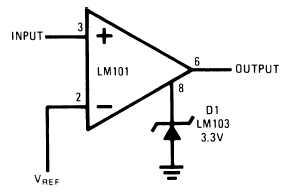circuits
schematics
diagrams
FreeCircuits.net

Voltage Comparators
By Robert J. Widlar
The LM101 is well suited to comparator applications for two reasons: first, it has a large differential input voltage range and, second, the output is easily clamped to make it compatible with various driver and logic circuits. It is true that it doesn’t have the speed of the LM7104 (10 μs versus 40 ns, under equivalent conditions); however, in many linear applications speed is not a problem and the lower input currents along with higher voltage capability of the LM101 is a tremendous benefit.

Figure 1. Comparator for driving DTL and TTL integrated circuits

Figure 2. Comparator and Lamp Driver
Two comparator circuits using the LM101 are shown in Figures 1,2. The one in Figure 1 shows a clamping scheme which makes the output signal directly compatible with DTL or TTL integrated circuits. An LM103 breakdown diode clamps the output at 0V or 4V in the low or high states, respectively. This particular diode was chosen because it has a sharp breakdown and low equivalent capacitance. When working as a comparator, the amplifier operates open loop so normally no frequency compensation is needed. Nonetheless, the stray capacitance between Pins 5 and 6 of the amplifier should be minimized to prevent low level oscillations when the comparator is in the active region. If this becomes a problem a 3 pF capacitor on the normal compensation terminals will eliminate it.
Figure 2 shows the connection of the LM101 as a comparator and lamp driver. Q1 switches the lamp, with R2 limiting the current surge resulting from turning on a cold lamp. R1 determines the base drive to Q1 while D1 keeps the amplifier from putting excessive reverse bias on the emitter-base junction of Q1 when it turns off.
 1515
1515 ![]() 08 December 2007
08 December 2007
